Anna V. Kononova
From Spikes to Speech: NeuroVoc -- A Biologically Plausible Vocoder Framework for Auditory Perception and Cochlear Implant Simulation
Jun 04, 2025Abstract:We present NeuroVoc, a flexible model-agnostic vocoder framework that reconstructs acoustic waveforms from simulated neural activity patterns using an inverse Fourier transform. The system applies straightforward signal processing to neurogram representations, time-frequency binned outputs from auditory nerve fiber models. Crucially, the model architecture is modular, allowing for easy substitution or modification of the underlying auditory models. This flexibility eliminates the need for speech-coding-strategy-specific vocoder implementations when simulating auditory perception in cochlear implant (CI) users. It also allows direct comparisons between normal hearing (NH) and electrical hearing (EH) models, as demonstrated in this study. The vocoder preserves distinctive features of each model; for example, the NH model retains harmonic structure more faithfully than the EH model. We evaluated perceptual intelligibility in noise using an online Digits-in-Noise (DIN) test, where participants completed three test conditions: one with standard speech, and two with vocoded speech using the NH and EH models. Both the standard DIN test and the EH-vocoded groups were statistically equivalent to clinically reported data for NH and CI listeners. On average, the NH and EH vocoded groups increased SRT compared to the standard test by 2.4 dB and 7.1 dB, respectively. These findings show that, although some degradation occurs, the vocoder can reconstruct intelligible speech under both hearing models and accurately reflects the reduced speech-in-noise performance experienced by CI users.
Towards a Deeper Understanding of Reasoning Capabilities in Large Language Models
May 15, 2025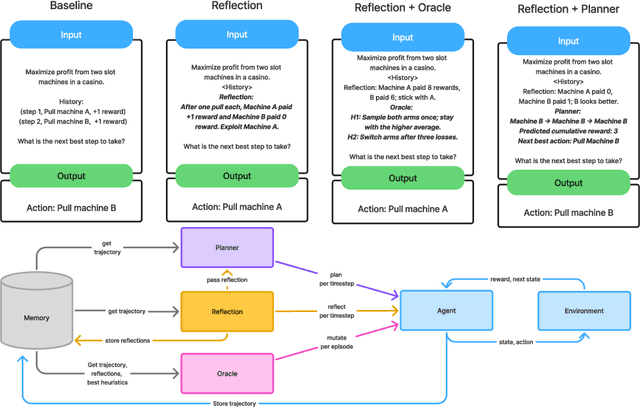
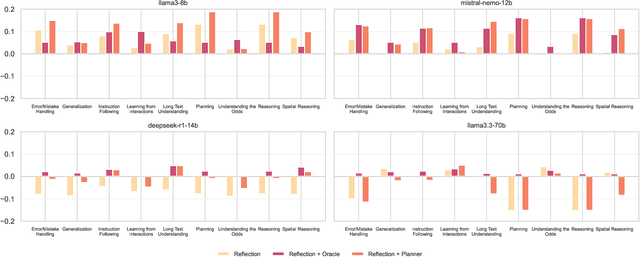
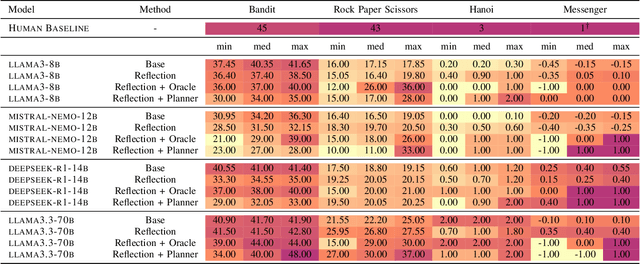
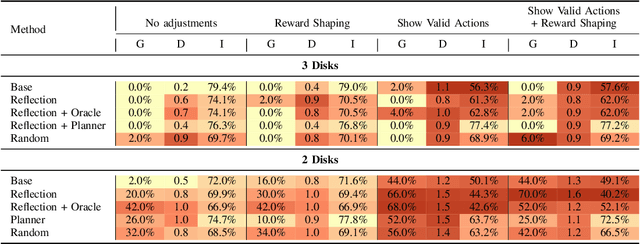
Abstract:While large language models demonstrate impressive performance on static benchmarks, the true potential of large language models as self-learning and reasoning agents in dynamic environments remains unclear. This study systematically evaluates the efficacy of self-reflection, heuristic mutation, and planning as prompting techniques to test the adaptive capabilities of agents. We conduct experiments with various open-source language models in dynamic environments and find that larger models generally outperform smaller ones, but that strategic prompting can close this performance gap. Second, a too-long prompt can negatively impact smaller models on basic reactive tasks, while larger models show more robust behaviour. Third, advanced prompting techniques primarily benefit smaller models on complex games, but offer less improvement for already high-performing large language models. Yet, we find that advanced reasoning methods yield highly variable outcomes: while capable of significantly improving performance when reasoning and decision-making align, they also introduce instability and can lead to big performance drops. Compared to human performance, our findings reveal little evidence of true emergent reasoning. Instead, large language model performance exhibits persistent limitations in crucial areas such as planning, reasoning, and spatial coordination, suggesting that current-generation large language models still suffer fundamental shortcomings that may not be fully overcome through self-reflective prompting alone. Reasoning is a multi-faceted task, and while reasoning methods like Chain of thought improves multi-step reasoning on math word problems, our findings using dynamic benchmarks highlight important shortcomings in general reasoning capabilities, indicating a need to move beyond static benchmarks to capture the complexity of reasoning.
BLADE: Benchmark suite for LLM-driven Automated Design and Evolution of iterative optimisation heuristics
Apr 28, 2025Abstract:The application of Large Language Models (LLMs) for Automated Algorithm Discovery (AAD), particularly for optimisation heuristics, is an emerging field of research. This emergence necessitates robust, standardised benchmarking practices to rigorously evaluate the capabilities and limitations of LLM-driven AAD methods and the resulting generated algorithms, especially given the opacity of their design process and known issues with existing benchmarks. To address this need, we introduce BLADE (Benchmark suite for LLM-driven Automated Design and Evolution), a modular and extensible framework specifically designed for benchmarking LLM-driven AAD methods in a continuous black-box optimisation context. BLADE integrates collections of benchmark problems (including MA-BBOB and SBOX-COST among others) with instance generators and textual descriptions aimed at capability-focused testing, such as generalisation, specialisation and information exploitation. It offers flexible experimental setup options, standardised logging for reproducibility and fair comparison, incorporates methods for analysing the AAD process (e.g., Code Evolution Graphs and various visualisation approaches) and facilitates comparison against human-designed baselines through integration with established tools like IOHanalyser and IOHexplainer. BLADE provides an `out-of-the-box' solution to systematically evaluate LLM-driven AAD approaches. The framework is demonstrated through two distinct use cases exploring mutation prompt strategies and function specialisation.
Graphical Models for Decision-Making: Integrating Causality and Game Theory
Apr 16, 2025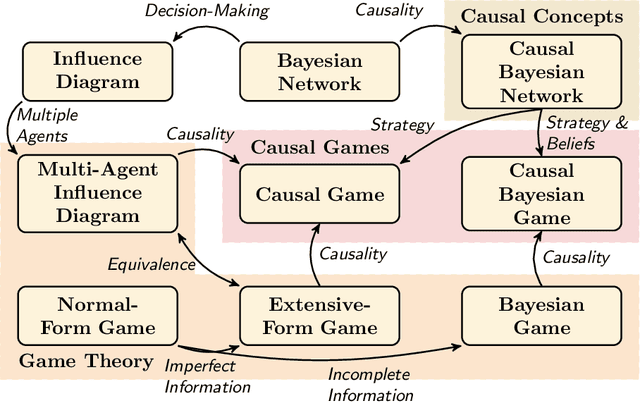
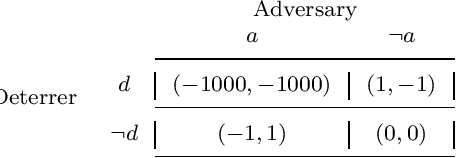
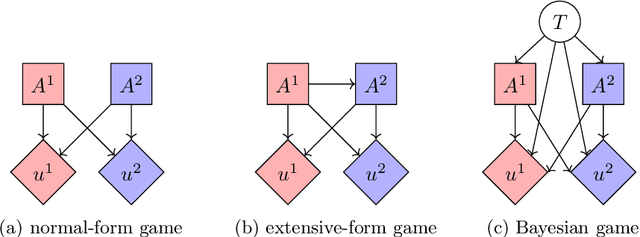
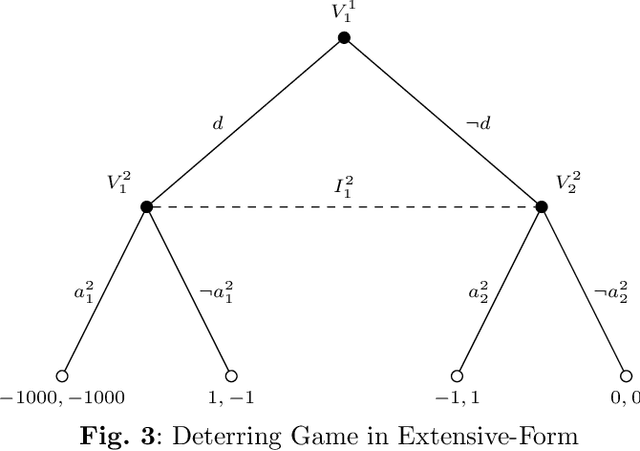
Abstract:Causality and game theory are two influential fields that contribute significantly to decision-making in various domains. Causality defines and models causal relationships in complex policy problems, while game theory provides insights into strategic interactions among stakeholders with competing interests. Integrating these frameworks has led to significant theoretical advancements with the potential to improve decision-making processes. However, practical applications of these developments remain underexplored. To support efforts toward implementation, this paper clarifies key concepts in game theory and causality that are essential to their intersection, particularly within the context of probabilistic graphical models. By rigorously examining these concepts and illustrating them with intuitive, consistent examples, we clarify the required inputs for implementing these models, provide practitioners with insights into their application and selection across different scenarios, and reference existing research that supports their implementation. We hope this work encourages broader adoption of these models in real-world scenarios.
Optimizing Photonic Structures with Large Language Model Driven Algorithm Discovery
Mar 25, 2025

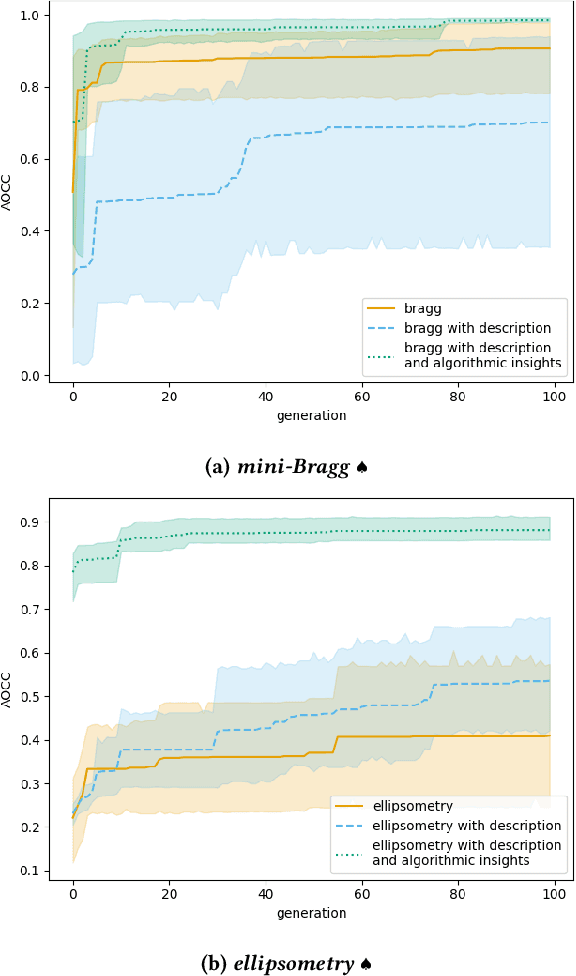
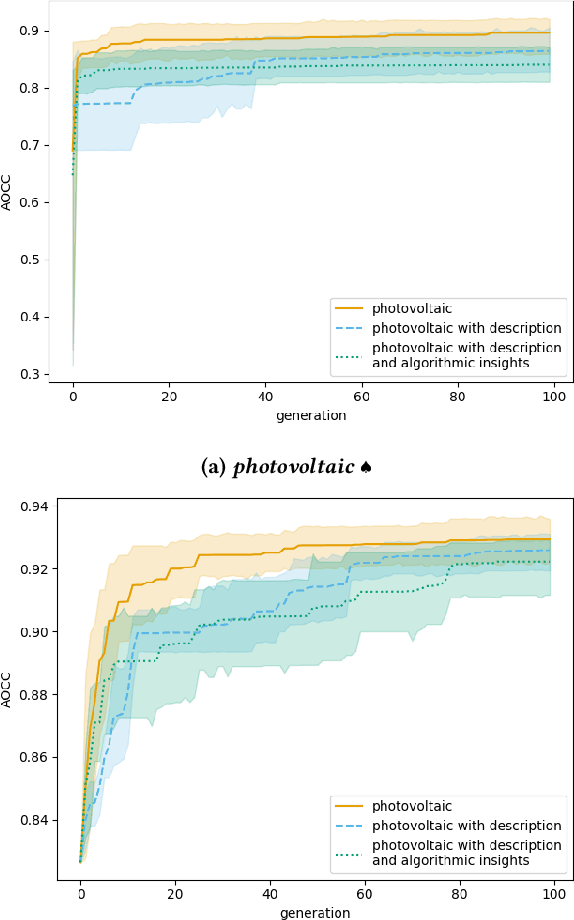
Abstract:We study how large language models can be used in combination with evolutionary computation techniques to automatically discover optimization algorithms for the design of photonic structures. Building on the Large Language Model Evolutionary Algorithm (LLaMEA) framework, we introduce structured prompt engineering tailored to multilayer photonic problems such as Bragg mirror, ellipsometry inverse analysis, and solar cell antireflection coatings. We systematically explore multiple evolutionary strategies, including (1+1), (1+5), (2+10), and others, to balance exploration and exploitation. Our experiments show that LLM-generated algorithms, generated using small-scale problem instances, can match or surpass established methods like quasi-oppositional differential evolution on large-scale realistic real-world problem instances. Notably, LLaMEA's self-debugging mutation loop, augmented by automatically extracted problem-specific insights, achieves strong anytime performance and reliable convergence across diverse problem scales. This work demonstrates the feasibility of domain-focused LLM prompts and evolutionary approaches in solving optical design tasks, paving the way for rapid, automated photonic inverse design.
Code Evolution Graphs: Understanding Large Language Model Driven Design of Algorithms
Mar 20, 2025
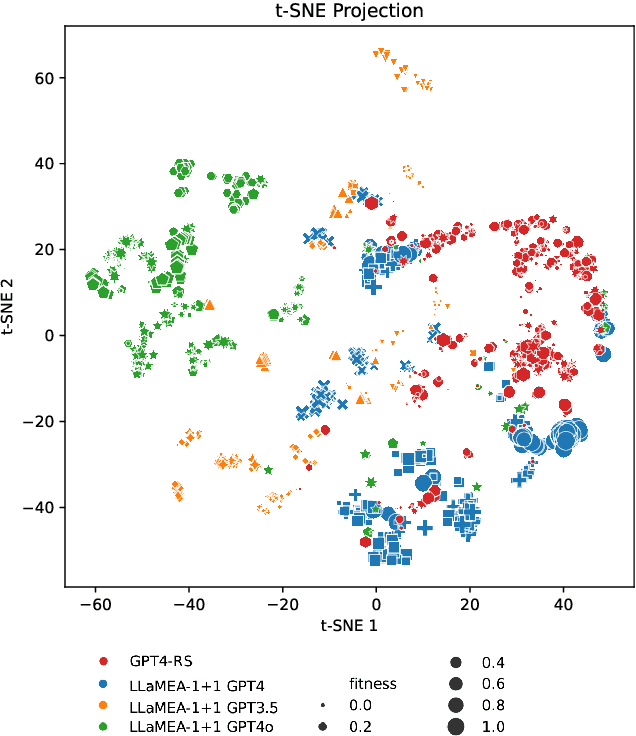
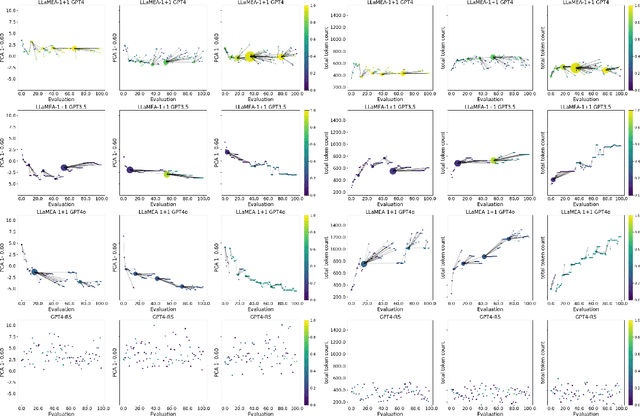

Abstract:Large Language Models (LLMs) have demonstrated great promise in generating code, especially when used inside an evolutionary computation framework to iteratively optimize the generated algorithms. However, in some cases they fail to generate competitive algorithms or the code optimization stalls, and we are left with no recourse because of a lack of understanding of the generation process and generated codes. We present a novel approach to mitigate this problem by enabling users to analyze the generated codes inside the evolutionary process and how they evolve over repeated prompting of the LLM. We show results for three benchmark problem classes and demonstrate novel insights. In particular, LLMs tend to generate more complex code with repeated prompting, but additional complexity can hurt algorithmic performance in some cases. Different LLMs have different coding ``styles'' and generated code tends to be dissimilar to other LLMs. These two findings suggest that using different LLMs inside the code evolution frameworks might produce higher performing code than using only one LLM.
Abnormal Mutations: Evolution Strategies Don't Require Gaussianity
Feb 05, 2025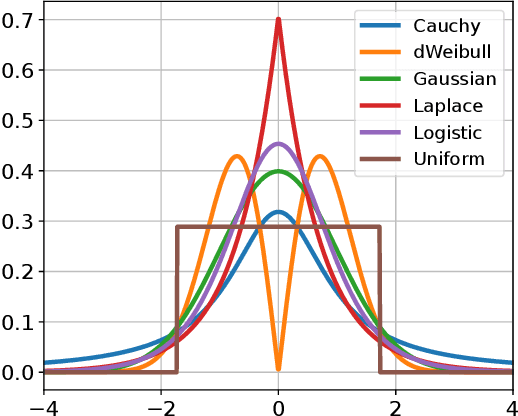

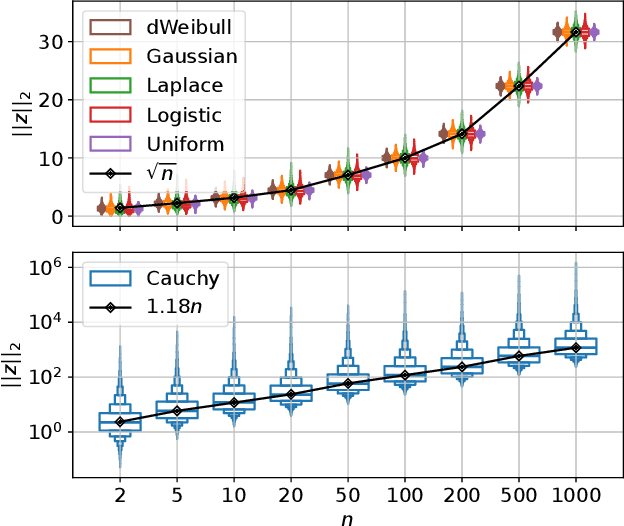

Abstract:The mutation process in evolution strategies has been interlinked with the normal distribution since its inception. Many lines of reasoning have been given for this strong dependency, ranging from maximum entropy arguments to the need for isotropy. However, some theoretical results suggest that other distributions might lead to similar local convergence properties. This paper empirically shows that a wide range of evolutionary strategies, from the (1+1)-ES to CMA-ES, show comparable optimization performance when using a mutation distribution other than the standard Gaussian. Replacing it with, e.g., uniformly distributed mutations, does not deteriorate the performance of ES, when using the default adaptation mechanism for the strategy parameters. We observe that these results hold not only for the sphere model but also for a wider range of benchmark problems.
Stalling in Space: Attractor Analysis for any Algorithm
Dec 20, 2024



Abstract:Network-based representations of fitness landscapes have grown in popularity in the past decade; this is probably because of growing interest in explainability for optimisation algorithms. Local optima networks (LONs) have been especially dominant in the literature and capture an approximation of local optima and their connectivity in the landscape. However, thus far, LONs have been constructed according to a strict definition of what a local optimum is: the result of local search. Many evolutionary approaches do not include this, however. Popular algorithms such as CMA-ES have therefore never been subject to LON analysis. Search trajectory networks (STNs) offer a possible alternative: nodes can be any search space location. However, STNs are not typically modelled in such a way that models temporal stalls: that is, a region in the search space where an algorithm fails to find a better solution over a defined period of time. In this work, we approach this by systematically analysing a special case of STN which we name attractor networks. These offer a coarse-grained view of algorithm behaviour with a singular focus on stall locations. We construct attractor networks for CMA-ES, differential evolution, and random search for 24 noiseless black-box optimisation benchmark problems. The properties of attractor networks are systematically explored. They are also visualised and compared to traditional LONs and STN models. We find that attractor networks facilitate insights into algorithm behaviour which other models cannot, and we advocate for the consideration of attractor analysis even for algorithms which do not include local search.
Controlling the Mutation in Large Language Models for the Efficient Evolution of Algorithms
Dec 04, 2024Abstract:The integration of Large Language Models (LLMs) with evolutionary computation (EC) has introduced a promising paradigm for automating the design of metaheuristic algorithms. However, existing frameworks, such as the Large Language Model Evolutionary Algorithm (LLaMEA), often lack precise control over mutation mechanisms, leading to inefficiencies in solution space exploration and potentially suboptimal convergence. This paper introduces a novel approach to mutation control within LLM-driven evolutionary frameworks, inspired by theory of genetic algorithms. Specifically, we propose dynamic mutation prompts that adaptively regulate mutation rates, leveraging a heavy-tailed power-law distribution to balance exploration and exploitation. Experiments using GPT-3.5-turbo and GPT-4o models demonstrate that GPT-3.5-turbo fails to adhere to the specific mutation instructions, while GPT-4o is able to adapt its mutation based on the prompt engineered dynamic prompts. Further experiments show that the introduction of these dynamic rates can improve the convergence speed and adaptability of LLaMEA, when using GPT-4o. This work sets the starting point for better controlled LLM-based mutations in code optimization tasks, paving the way for further advancements in automated metaheuristic design.
A Dataset for Evaluating Online Anomaly Detection Approaches for Discrete Multivariate Time Series
Nov 21, 2024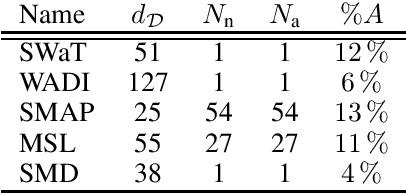
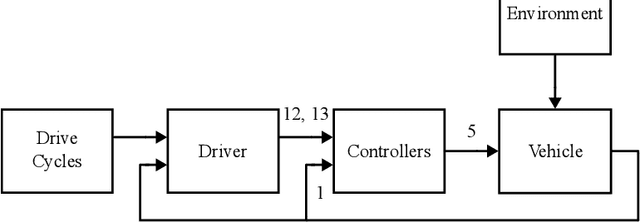
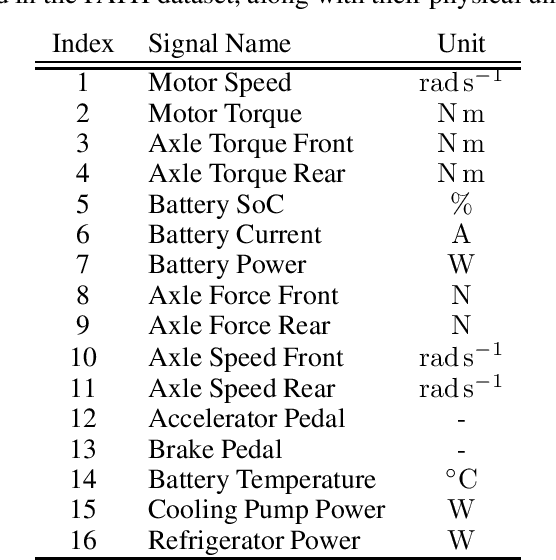
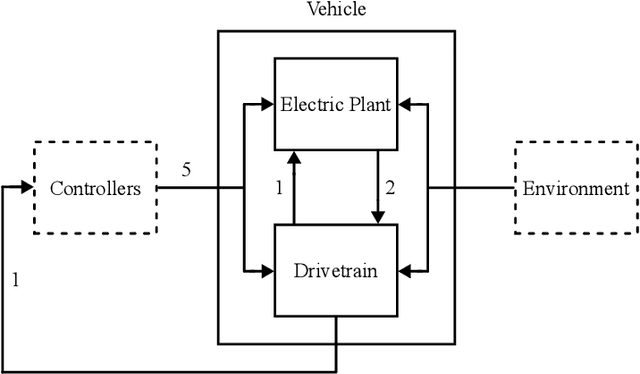
Abstract:Benchmarking anomaly detection approaches for multivariate time series is challenging due to the lack of high-quality datasets. Current publicly available datasets are too small, not diverse and feature trivial anomalies, which hinders measurable progress in this research area. We propose a solution: a diverse, extensive, and non-trivial dataset generated via state-of-the-art simulation tools that reflects realistic behaviour of an automotive powertrain, including its multivariate, dynamic and variable-state properties. To cater for both unsupervised and semi-supervised anomaly detection settings, as well as time series generation and forecasting, we make different versions of the dataset available, where training and test subsets are offered in contaminated and clean versions, depending on the task. We also provide baseline results from a small selection of approaches based on deterministic and variational autoencoders, as well as a non-parametric approach. As expected, the baseline experimentation shows that the approaches trained on the semi-supervised version of the dataset outperform their unsupervised counterparts, highlighting a need for approaches more robust to contaminated training data.
 Add to Chrome
Add to Chrome Add to Firefox
Add to Firefox Add to Edge
Add to Edge